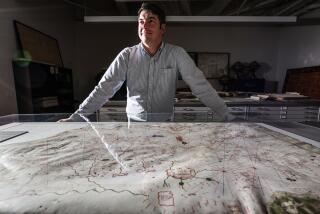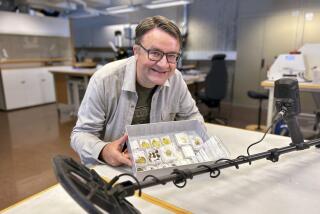Manuscript Collector Thrills to Discoveries
OSLO â When Martin Schoyen was 15, he spotted some old books for sale at a Sunday market in Florence, Italy.
The young Norwegian bought one, from 1592, for about 3 cents.
So began a passion that, 47 years later, has resulted in one of the worldâs largest collections of ancient manuscripts, with an estimated value of up to $105 million.
âItâs the excitement of finding that these things exist,â said Schoyen, 62. He added that everything was legally obtained.
The 12,500-piece collection spans five millenniums. It includes parts of the Dead Sea Scrolls, an ancient Buddhist writing rescued from the Taliban, ancient symbols used by Australiaâs Aborigines and a signet ring used by Egyptâs King Tutankhamen.
Schoyen is considering selling the collection, although he is not actively marketing it. If sold, all revenues would go into his Schoyen Human Rights Foundation to support free speech, human rights and development aid.
Norway may be a potential buyer. But the government has remained noncommittal amid a spirited debate over whether such a purchase would be appropriate.
Proponents such as national librarian Bendik Rugaas say the government should leap at the chance, while skeptics like Sissel Nilsen, director of the National Libraryâs Oslo division, question the nationâs will to care for the treasures it already has.
Egyptâs ambassador, Nermine Mourad, is among those who want proof that Schoyenâs treasures are his to sell because âif any were obtained illegally, this has to be settled.â
Many researchers are delighted by his costly hobby since everything is available for study and publication. Much also is on loan to institutions and museums.
Schoyen, an engineer who built his fortune from a bus company inherited from his father, is currently cruising the globe aboard The World, a new Norwegian-built luxury condominium ship on which he owns a vacation home.
In an e-mail interview from the ship, he recalled the excitement of that first book, bought during a summer vacation with his parents.
The work, âManuale del Navarro,â was interesting enough. But it was what Schoyen found inside the binding that really piqued his interest: a handwritten religious sermon in French from around 1300.
Since then, he has collected at auctions, through dealers and by bullheaded detective work.
For example, obtaining fragments from the Dead Sea Scrolls, the priceless Jewish history believed written between 250 B.C. and A.D. 70, seemed hopeless. The more than 15,000 documents, found in the 1940s and 1950s in a cave near Jericho on the West Bank, were held by institutions, with none -- experts believed -- in private hands.
Schoyen recalled that two American students, John C. Trever and William Brownlee, were the first Westerners to see, study and photograph the scrolls in 1947 and speculated they may have received fragments from the owner -- Syrian orthodox archbishop Athanasius Samuel of St. Marks monastery in Jerusalem -- as a token for their work. He tracked the men to California, where they had been professors at the School of Theology in Claremont.
âYes, they both got fragments as gifts, but mostly without any writing on them, and therefore they gladly parted with them at a modest price,â Schoyen said.
Infrared photography later revealed that some fragments did have writing, âincluding the worldâs oldest MS [manuscript] of the book of Daniel,â Schoyen said.
He also helped rescue ancient Buddhist writings in 1995 after the Taliban took power in Afghanistan and imposed a harsh form of Islam that included destroying relics of any other religion. The Buddhist scrolls -- from the 1st to the 7th centuries -- were found in central Afghanistanâs Bamiyan province in caves near towering Buddhist statues that the now-ousted Taliban blew up in 2001 as âun-Islamicâ idols.
Schoyen bought smuggled-out scrolls, mostly in fragments, and funded a rescue effort for the rest. He lent the fragments, on palm leaves, bark and other materials, to Jens Braarvig, a specialist in Buddhist writings at the Academy of Science in Oslo, for study.
âThese are some of the oldest known Buddhist texts,â Braarvig said.
Researchers are piecing together about 10,000 fragments like a puzzle. Braarvig said the scrolls probably originated in India.
A favorite piece?
âWould you ask a mother which of her many children were closest to her heart?â Schoyen fired back over the Internet.
More to Read
Sign up for Essential California
The most important California stories and recommendations in your inbox every morning.
You may occasionally receive promotional content from the Los Angeles Times.










